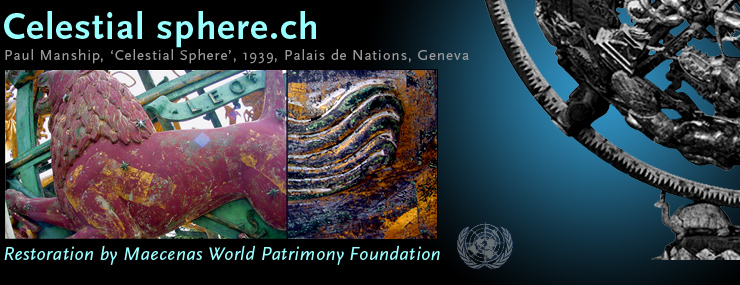| |
|
|
The History
|
The huge -over four meter diameter- Celestial Sphere is the chef d'oeuvre of the American sculptor Paul Manship (1885-1966). Manship is considered to be the most prominent American artist of the 'style moderne' or as it is more widely known, 'Art Deco'.
Beginning in 1927 and for the next twelve years Manship was occupied with a series of monumental works including the "Prometheus Fountain" at Rockefeller Centre, New York, and the 'Moods of Time' groups, executed for the New York World's Fair of 1939-40. This period of great creativity was culminated by the production of the monumental Woodrow Wilson Memorial Sphere for the Palais des Nations.
Contacted in late 1935 by the Board of the Woodrow Wilson Foundation, Manship was asked to provide an idea for a memorial to President Woodrow Wilson as the founding father of the League of Nations. At that time the Palais des Nations was still under construction. Manship's proposal for a monumental celestial sphere was accepted and a commission for the project was awarded to him in April of 1936. At his atelier, Manship gathered a team of sculptors and other artists to work on the various aspects of the design. The team included such famous names as Angelo Colombo and Giuseppe Massari, and Richard Pousette-Dart, the renowned painter, who collaborated with Herbert Kammerer on the lettering of the sphere. The final plaster moulds were executed by Hyman Flitzer.
The Geneva 'Celestial Sphere' was based upon several pre-existing versions, including the earliest state of this composition, the Aero-Memorial in Philadelphia, Pennsylvania. It differs from these in that the Sphere is supported upon the backs of four tortoises, taken from his models for the gates to the New York Bronx Zoo, which in turn rest upon a stepped socle bearing a cast representation of the Chinese "celestial sea" (Hai Shui Jiang Ya). The tortoises may therefore be thought to represent the Chinese tortoise of immortality (Ao) - an auspicious symbol from Tang times on. Other Zodiac signs come from the world's major civilizations, both past and present.
The sphere was motorized and, in the words of the artist, designed 'so that it would rotate slowly' and was intended to be illuminated at night.
The original plaster moulds, executed by Flitzer, were ready in 1938 and were sent to the Bruno Bearzi Atelier in Florence for casting. The elements of the sphere were cast from these plaster moulds by Bearzi using a cire-perdu process from a bronze/zinc high-tin alloy with added lead. The constellations were originally gilded and applied stars, chrome-silvered. The meridians and architectural elements of the composition have been variously nielloed.
The celestial sphere measures 410 cm. in diameter and weighs some 5.800 kg. As his signature, it bears Manship's self-portrait with his tools, in profile, hidden among the constellations. The sphere was installed in its present location by the Bearzi Atelier in August of 1939.
|
| |
| |
|
|
